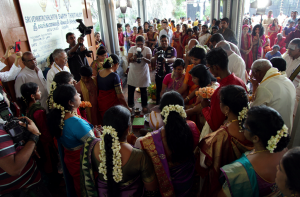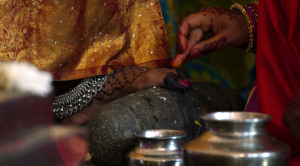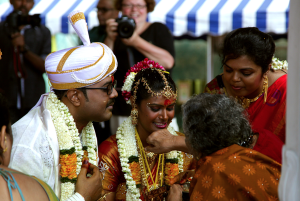When wandering through temples anywhere in Asia, it’s not unusual to stumble across some sort of celebration, ceremony or ritual as it carries on. Used to tourists, those participating carelessly overlook those slinking around, hugging the walls and doorways. But there was something different about the atmosphere and its undeniable activity swirling through the Hindu temple – one of the oldest in Malaysia – at the base of Kuala Lumpur’s famous Batu Caves.
Kids were running around the temple, dodging monkeys and pigeons as they played soccer with a makeshift ball, grabbing onto each other’s dhotis of different brilliant colors, jewelry tied up in girls’ hair, golden charms strung across their foreheads and jingling as they skipped, glinting in the sunlight.
I kicked off my shoes into the piles at the temple’s foot and my instant disappointment at the crowds tapered as a chorus of wind instruments sung from inside the open-air temple, dhol drums keeping the beat. Women wrapped in beautiful saris and wearing faces full of colorful makeup lounged on the floor, all eyes ahead toward a mass of people crowded in a circle, the rogue tourist poking their head through the group. To the flanks, people systematically received blessings from pujari – Hindu temple priests – deep in focus as the clamor crescendoed all around them.

Cheers erupted and the tightly wound crowd burst open, a woman in a deep red wedding sari (typical to Southern an Eastern India, I was told) glided out, almost dancing as she walked, her hand held firmly by the man at her side.
An idle pujari standing near me leaned over silently.
“Wedding,” he said matter-of-factly.
Watching of the ceremony unfold was absolutely stunning. The colors, the energy, the commotion was all heightened and loud and emitted this energy you could physically absorb.
But what was even more amazing was that this wedding itself was more or less one-of-a-kind – as are most Indian weddings.
India is quite possibly the most diverse place on the planet – religiously, linguistically, culturally… really in every way imaginable. So it stands to reason that every single pocket of India has maintained its own unique ethos. So when two people from different parts of India join together in marriage, each brings with them their own customs and traditions from the very start, at the wedding.
Almost 800 languages are reportedly spoken throughout the Indian subcontinent but wedding ceremonies are now most frequently held in one of three: Tamil, Telugu or Malayalam – though the small rituals are usually carried out in Sanskrit.
Raju, a friend of the bride, explained to me the vast diversity of the Indian subcontinent and how it reflects on the tradition of weddings specifically.
He said that hundreds and hundreds of rituals and traditions are carried on throughout Indian weddings, but as independent cultures have increasingly overlapped, the customs of several have risen to popularity.
Several customs are carried throughout almost all Hindu weddings:
Kanyadaan
The giving away of the daughter by the father. The father takes his daughter’s hand and places it in the groom’s.
Panigrahana
The groom takes the bride’s hand as a sign of the union – often this occurs in the presence of fire, the flame a sign of a new household.
Saptapadi
Often performed near a fire, the bridegroom and bride exchange vows during this ritual, sometimes referred to as the Seven Step ritual. The vows are read in Sanskrit or the local language of the bride and groom, and sometimes said as the bride and groom walk around a fire with pieces of each other’s clothing tied to each other.
But regionally, hundreds of other localized customs are woven into individual Indian weddings, creating a unique experience each time. But according to Raju, as weddings across communities have become increasingly common, three popular traditions have arisen:
Toe Ring
Toe rings have been part of Hindu Indian culture since ancient times. Reportedly the tradition began within the text of the epic Ramayana. (In the text, when Sita is taken by Ravana, she throws away her toe ring as identification for Lord Rama.) In modern day, it’s also believed that the silver ring balances a woman’s menstrual cycle, keep healthy blood pressure and reproductive health and refresh the whole body.

In many Indian cultures the bridegroom puts the silver toe ring on the bride’s foot (usually the second toe) during the ceremony, usually in pairs. The ring is most commonly referred to by its Hindi name – bichiya.
Thali Necklace
The Thali Necklace is a sacred necklace the Hindu groom ties around the bride’s neck, often bought by the groom’s family. The woman wears the necklace as a sign of her marital status, and the custom originated in the South of India.
Tying the knot around the bride’s neck signifies the inseparable union of the two people. The necklace is also known as a Mangala sutram.
Henna and Tilak
Along travel routes, you’ll find tourists donning ornate designs dyed into the skin along their hands, arms and feet – but the henna tattoos are actually a very sacred part of many Indian weddings. A ceremony accompanies adorning the bride’s hands and feet with henna, and it’s believed that the longer the henna stays on her body, the longer it is believed her in-laws will treat her well. If it fades quickly, the marriage will be unhappy.

The bridegroom experiences a similar ceremony to have his forehead anointed with a tilak – smearing powder or paste on the forehead, typically in red for the wedding.
—-
Following the wedding ceremony, the groom’s family welcomes the bride and her family into their household, which is called Grihapravesa, during which the two families get to know each other. The union of the family is as important as the marriage of two individuals in Indian society, and since the two families are likely to come from different areas with different backgrounds, traditions and customs, the rituals of the wedding are meant to facilitate a deeper understanding between the two.

